The Stirling Range Mountain Bells
Darwinia
The genus Darwinia was first identified and named by Edward Rudge in a paper entitled ďA description of several new species of plants from New HollandĒ, published in the transactions of the Linnean Society in 1815. It was based on Rudge's examination of some plant specimens he received from south east Australia. Since then over 60 different Darwinia species have been found in south east and south west Australia, with most occurring in the south west.
The genus forms part of the Myrtaceae family and is endemic to Australia. |
|
What are Mountain Bells?
The Mountain Bells form a subgroup of the Darwinia genus. They tend to grow high up on the mountain slopes and are characterised by their large colourful bracts hanging down, bell like, from the ends of spindly branches. These bells enclose the tiny flowers. The petals of the flowers are small and indistinct, but the styles with their pollen presenters are prominent and often visible peeking out from the bells.
The Darwinia squarrosa (left) has some of its bracts missing. It shows the tiny flowers with long styles inside. This is typical of the mountain bells.
Of the ten Known species that comprise this group only one, Darwinia carnea, occurs outside the Stirling Range. They all flower in spring and, less profusely, in autumn. |
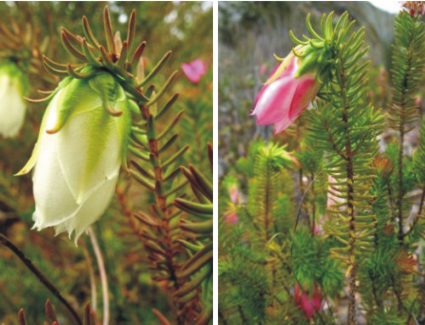 |
| An all white Darwinia lejostyla on Baker's Knob | Darwinia lejostyla on Ellen's Peak |
Darwinea Lejostyla (The Common Mountain Bell)
Probably the most widespread of the mountain bells, it occurs all along the Stirling Ridge from Ellenís Peak to Mount Success, and reappears on the other side of Chester Pass, on Tollís Peak and Mount Trio. It grows on the high mountain ridges, along the back of Pyungoorup Peak and on the upper slopes of Ellenís Peak, where it is a small heath like shrub. It also grows down in the valleys, where it can be found at the start of the tourist track up Bluff knoll, and close to the Mount Trio car park. Here it grows to over a meter high.
The leaves are short, dense and linear, and about 8 mm in length.
The colour of the outer bracts can vary from bright pink to a paler pink, pink and white, and on Bakers Knob I have found several plants with all white bracts. In general the bells on the far eastern peaks are paler in colour, though this can vary from year to year. Each bell contains 7 or 8 flowers.
|
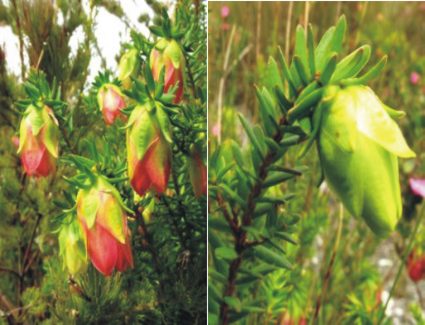 |
| Darwinia collina x lejostyla |
Darwinia collina |
On Bakers Knob Darwinia lejostyla grows alongside Darwinia collina and several hybrids of the two occur.
Lejostyla has also hybridised with a rare mountain bell that is only found on one remote eastern peak.
Darwinia collina (The Yellow Mountain Bell) (left)
Found only on the summits of Bluff Knoll and Bakers Knob, the Darwinia collina has yellow to lime green bracts enclosing eleven flowers. The styles can often be seen, just protruding from the bracts.
The leaves are spatulate and about 8mm in length.
|
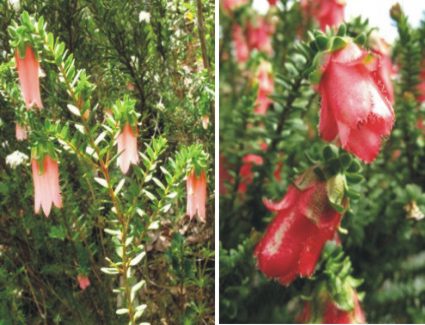 |
| Darwinia squarrosa at the top of the north Isongerup Track |
Darwinia squarrosa on Isongerup Peak |
Darwinia squarrosa (The Pink Mountain Bell) (right)
Another fairly wide ranging mountain bell, the Darwinia squarrosa can be found along the Stirling Ridge from Isongerup Peak to Bluff Knoll. It occurs both on the mountain tops and lower down in the valleys and is prolific on the steep northern slopes of Bluff Knoll, producing a magnificent display when viewed from the tourist track traversing the scarp.
The coloured bracts vary from deep pink to pale pink and are fringed with fine hairs. There are 9 flowers inside the bracts and the styles do not quite protrude.
The leaves are spatulate, about 1 cm long, and also fringed with fine hairs.
|
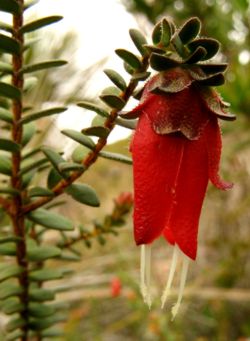 |
|
Darwinia sp (above)
This extremely rare Darwinia only occurs on one small and remote hill in the eastern peaks. It has bright red bracts and is similar to Darwinia squarrosa in that its leaves and bracts are fringed with fine hairs. However the bells are much smaller than squarrosa and the styles protrude well outside the bracts. The bells contain 4 or 5 flowers.
The leaves are spatulate and about 5 mm in length.
Several examples of hybrids with the Darwinia Lejostyla, which borders the colony, can be found in the same location. |
|
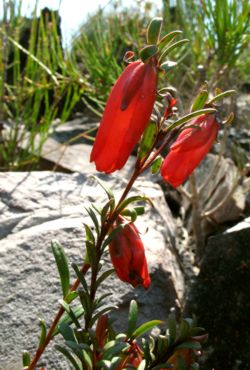 |
|
Darwinia hypericifolia (The Narrow Mountain Bell) (above)
This mountain bell is common on the central peaks to the west of Chester Pass; namely Mt. Hassel, Talyuberlup Peak, Mt. Gog, Barnet Peak and Henton Peak. It is found along the walking tracks up Mt. Hassel and Talyuberlup Peak.
The bells are long and narrow, and bright red. They each contain 5 flowers.
The leaves are narrow spatulate and about 15mm long.
|
|
 |
|
Darwinia wittwerorum (Wittwer's Mountain Bell) (above)
Wittwer's Darwinia is one of the more elusive mountain bells because it does not occur on any of the popular peaks. It is confined to a small area between Talyuberlup peak and Hostellers hills. Though extremely rare, it can be seen from Stirling Range Drive, about 100 metres north east of Talyuberlup car park. The straggling shrub grows to a metre high.
The bracts are coloured red and white, and form a rounded bell containing 7 flowers. The styles protrude slightly from the bracts.
The leaves are linear and up to 10mm long. |
|
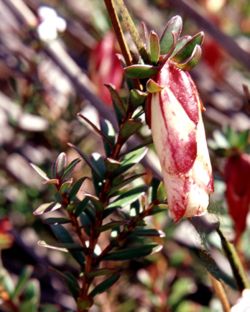 |
|
Darwinia macrostegia (The Mondurup Bell)(above)
I have only found this bell on Mondurup Peak, now closed to walkers; however, there are many reports of its occurrence in the Porongurup Range.
The bells are large, 3 to 4 cm long, and formed from white or pale cream bracts streaked with crimson veins. There can be up to 12 flowers contained within the bells.
The leaves are narrow spathulate and about 10mm long.
|
|
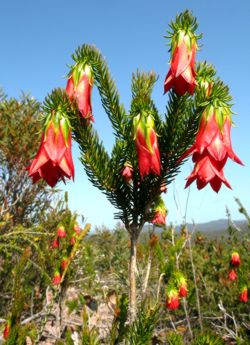 |
Darwinia oxylepsis (Gillams Bell) (below)
Another extremely rare Darwinia, which only grows on the low hills around Red Gum Pass, in the far west of the Stirling Range. A thriving colony can be found near the summit of Red Gum Hill.
Similar to Darwinia Lejostyla, except the bells are much larger, up to 3 cm long. The bracts are coloured bright red and contain 6 or 7 flowers.
|
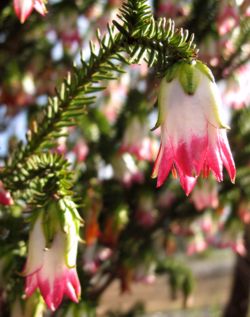 |
|
Darwinia meeboldii (The Cranbrook Bell) (above)
The floral emblem of Cranbrook, this bell is only found on the far western fringe of the Stirling Range National Park and most of this area is closed to walkers. However, the Cranbrook Bell can be seen at the wild-flower walk on the outskirts of Cranbrook.
The bells are quite large, about 3 cm long, and the bracts are white, tipped with bright pink or crimson. They contain 7 to 8 flowers and the styles protrude slightly from the bracts.
Leaves are linear and about 9mm long.
|
| Darwinia Vestita (The Pom-Pom Darwinia)
Another Darwinia commonly found along the fire-break tracks in the Stirling Range; however, it is not a mountain bell. The bracts are small and do not enclose the flowers. There's a
picture of Darwinia vestita on the heading picture frame of this page.
| Back to Stirling Range
Back to top |
|
Who's who in the Darwinia story
Erasmus Darwin (1731-1802)
A leading intellectual of eighteenth century England. He was one of the first naturalists to put forward a theory of evolution, in which he postulated that all life came from a single common ancestor. He didn't get as far as developing the idea of natural selection, but clearly put some ideas inside the head of his grand-son Charles.
The Darwinia genus was named inhonour of Erasmus Darwin, 13 years after his death.
Edward Rudge (1763-1846)
The English botanist and antiquary who first described, and named, the Darwinia as a separate genus. He studied plants sent back to England by various collectors in the colonies. In his paper entitled ďA description of several new species of plants from New HollandĒ, published in the transactions of the Linnean Society in 1815, he identified and named the new genus "Darwinia".
James Drummond (1787-1863)
A Scottish botanist and plant collector who accompanied James Stirling to Western Australia on board the Parmelia in 1829. He remained in the colony until his death in 1863.
He travelled widely, collecting large numbers of plant specimens and seeds, which he despatched to various British and European subscribers. In 1843 James, and his son Johnston, spent three months collecting around Albany and the Stirling Range. They have been attributed with collecting several mountain bells, including D. hypericifolia, D. lejostyla, D. macrostegia, and D. oxylepsis. However, they were not all immediately recognised as belonging to the Darwinia genus.
|










